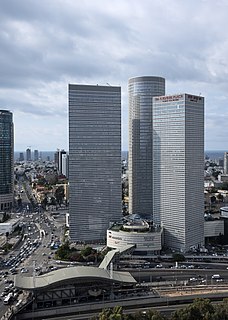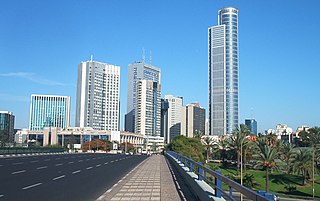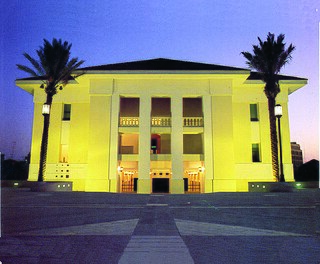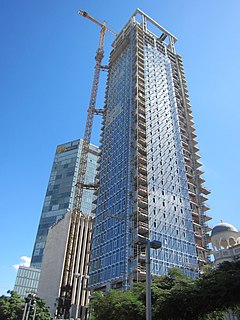
Tel Aviv-Yafo, often referred to as just Tel Aviv, is the most populous city in the Gush Dan metropolitan area of Israel. Located on the Israeli Mediterranean coastline and with a population of 460,613, it is the economic and technological center of the country. If East Jerusalem is considered part of Israel, Tel Aviv is the country's second most populous city after Jerusalem; if not, Tel Aviv is the most populous city ahead of West Jerusalem.

Tel Aviv Museum of Art is an art museum in Tel Aviv, Israel. The museum is dedicated to the preservation and display of modern and contemporary art from Israel and around the world.

Rabin Square, formerly Kings of Israel Square, is a main large public city square in the center of Tel Aviv, Israel. Over the years it has been the site of numerous political rallies, parades, and other public events. In 1995 the square was renamed 'Rabin Square' following the assassination of Yitzhak Rabin which occurred there on November 4th 1995.

The White City is a collection of over 4,000 buildings built in a unique form of the International Style in Tel Aviv from the 1930s, with a strong Bauhaus component, by Jewish architects from Germany and other Central and East European countries with German Cultural influences, who immigrated to the British Mandate of Palestine after the rise to power of the Nazis in Germany. Tel Aviv has the largest number of buildings in the Bauhaus/International Style of any city in the world. Preservation, documentation, and exhibitions have brought attention to Tel Aviv's collection of 1930s architecture. In 2003, the United Nations Educational, Scientific and Cultural Organization (UNESCO) proclaimed Tel Aviv's White City a World Cultural Heritage site, as "an outstanding example of new town planning and architecture in the early 20th century." The citation recognized the unique adaptation of modern international architectural trends to the cultural, climatic, and local traditions of the city. Bauhaus Center Tel Aviv organizes regular architectural tours of the city.

Neve Tzedek is a neighborhood located in southwestern Tel Aviv, Israel. It was the first Jewish neighborhood to be built outside the old city of the ancient port of Jaffa. Originally it was a Sephardi Jewish neighbourhood. Since the 1990s, rundown properties have been restored and it is now a fashionable quarter of Tel Aviv.

Azrieli Center is a complex of skyscrapers in Tel Aviv. At the base of the center lies a large shopping mall. The center was originally designed by Israeli-American architect Eli Attia, and after he fell out with the developer of the center David Azrieli, completion of the design was passed on to the Tel Aviv firm of Moore Yaski Sivan Architects.

Dizengoff Street is a major street in central Tel Aviv, named after Tel Aviv's first mayor, Meir Dizengoff.

Tzamarot Ayalon is a neighborhood of Tel Aviv, Israel, on the east-central side of the city. It is ranked as the wealthiest neighborhood in Israel.

The Diamond Exchange District is a diamond district and commercial area in the Tel Aviv District city of Ramat Gan, Israel. Bordering the Ayalon Highway, the freeway dividing Ramat Gan and Tel Aviv, the district is the hub of Israel's diamond industry as well as a major commercial center. As of 2019, the district contains 1.1 million square meters of commercial and living space, and is responsible for 60% of Ramat Gan's municipal revenue.

Dizengoff Square or Dizengoff Circus is an iconic public square in Tel Aviv, on the corner of Dizengoff Street, Reines Street and Pinsker Street. One of the city's main squares, it was built in 1934 and inaugurated in 1938.

Dizengoff Center is a shopping mall at the intersection of Dizengoff Street and King George Street in Tel Aviv, Israel. The mall is named for Meir Dizengoff, the first mayor of Tel Aviv.

Mamilla Mall, also called Alrov Mamilla Avenue, is an upscale shopping street and the only open-air mall in West Jerusalem. Located northwest of Jaffa Gate, the mall consists of a 2,000-foot (610 m) pedestrian promenade called Alrov Mamilla Avenue lined by 140 stores, restaurants, and cafes, and office space on upper floors. It sits atop a multi-story parking garage for 1,600 cars and buses, and a bus terminal. Designed by Moshe Safdie and developed by Alrov Properties and Lodgings Ltd. of Tel Aviv, the mall incorporates the facades of 19th-century buildings from the original Mamilla Street, as well as the original structures of the Convent of St. Vincent de Paul, the Stern House, and the Clark House.

The Suzanne Dellal Centre for Dance and Theatre is a centre for dance in Israel, located in Neve Tzedek, Tel Aviv.

Tel Aviv Port is a commercial and entertainment district in northwest Tel Aviv, Israel along the Mediterranean Sea.

Habima Square is a public major space in the center of Tel Aviv, Israel, which is home to a number of cultural institutions such as the Habima Theatre, the Culture Palace, and the Helena Rubinstein Pavilion for Contemporary Art. The square is at the intersection of Rothschild Boulevard, Hen Boulevard, Dizengoff Street, and Ben-Zion Boulevard.

Malkhei Yisrael Street, also spelled Malchei Yisrael, is an east-west street in the Geula neighborhood of north-central Jerusalem. Its eastern flank, which abuts Mea Shearim Street at an intersection called Kikar HaShabbat, is the main shopping district for Haredi Jewish residents of northern Jerusalem. The remainder of the street, which extends to Sarei Yisrael Street at its western end, includes the historic Schneller Compound and numerous Haredi and Hasidic yeshivas, girls' schools, and synagogues.

Atarim Square is a complex of buildings and a public square in Tel Aviv, Israel, designed by architect Yaakov Rechter.

London Ministores is a commercial center located in the corner of the streets Sha'ul HaMelekh and Ibn Gabirol in Tel Aviv Center, Israel, in the first floor and the basement floor of "Ne'ot Aviv House".

Meier on Rothschild is a skyscraper on Allenby Street in Tel Aviv, Israel. The tower is 158 meters and It is the second highest residential building in Israel after Nevve Nof Tower.
The Nightmare of the Vultures is a documentary of drones and a simulated drone attack that was shown Iranian state TV on 7 February 2014. The film gives a short history of the Iranian drone program, and depicts a simulated military counterattack against Israeli targets and American installations in the Persian Gulf. Iranian drones and missiles are shown bombarding Tel Aviv’s Kikar Hamedina square, Azrieli Towers skyscrapers, IDF’s The Kirya central command complex, Ben Gurion International Airport, Haifa’s Technion, nuclear reactor in Dimona, and several air force bases. In the film, Ali Khamenei, Supreme leader of Iran, states that Iranian drones and missiles are used just for defense against our enemies.



















